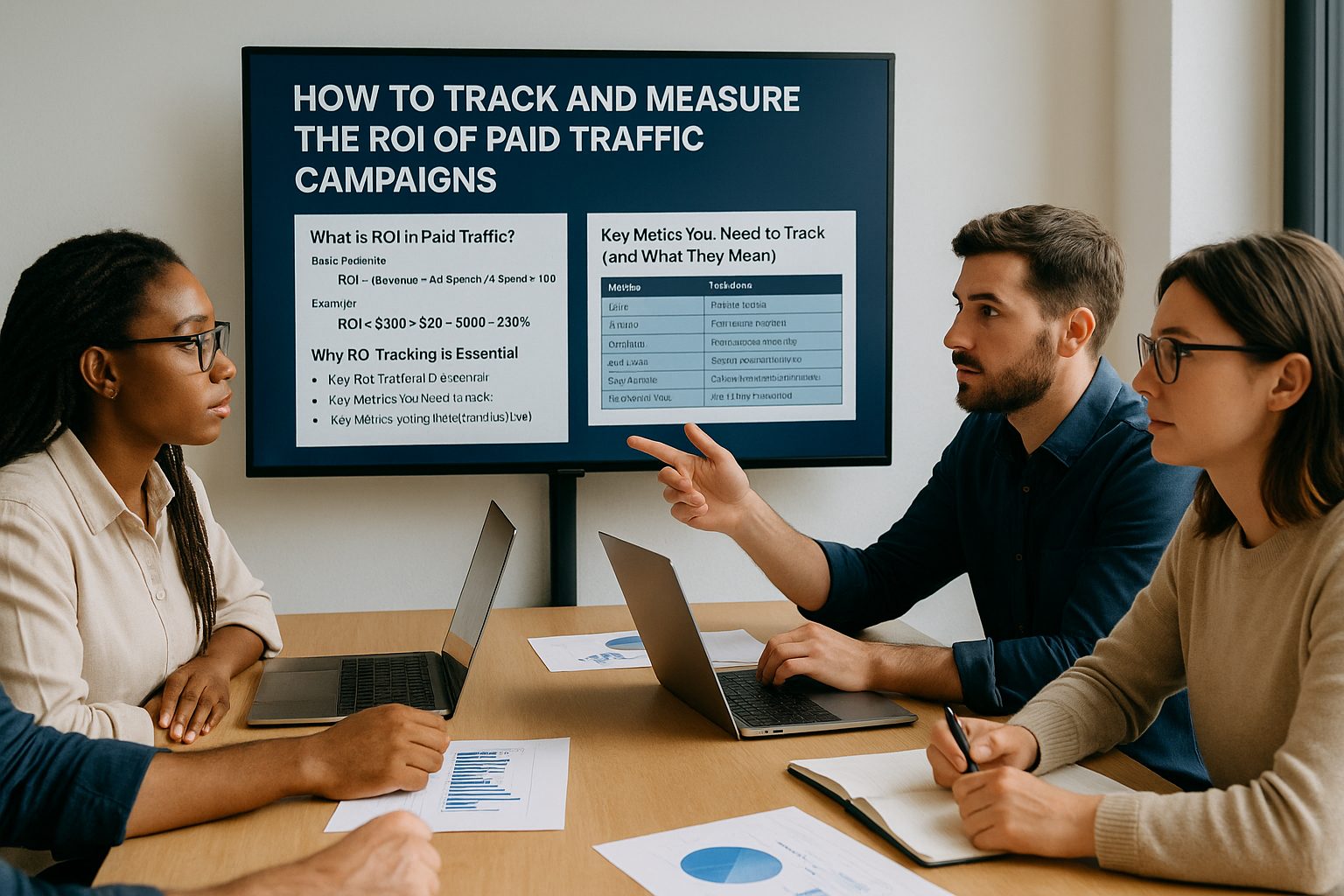Running ads without tracking ROI is like driving blindfolded — you’re moving, but you have no idea if you’re headed in the right direction.
Whether you’re spending $5 a day or $5,000, tracking your return on investment (ROI) is the only way to know if your traffic campaigns are profitable, scalable, and sustainable.
In this article, you’ll learn how to calculate ROI, which metrics really matter, and how to set up tracking that gives you clarity — not confusion.
What Is ROI in Paid Traffic?
ROI (Return on Investment) is the measurement of how much you get back from what you spent on ads.
Basic Formula:
iniCopiarEditarROI = (Revenue – Ad Spend) ÷ Ad Spend × 100
Example:
- You spend $500
- You generate $1,500 in revenue
- ROI = (1500 – 500) ÷ 500 × 100 = 200%
That means you earned $2 back for every $1 spent.
Why ROI Tracking Is Essential
✅ Shows if your campaigns are actually profitable
✅ Helps justify ad spend to clients or stakeholders
✅ Guides budget scaling decisions
✅ Reveals which campaigns to pause or boost
✅ Builds long-term strategy based on data
Without ROI tracking, you’re guessing — not managing.
Key Metrics You Need to Track (and What They Mean)
| Metric | What It Measures |
|---|---|
| CPC (Cost per Click) | How much you’re paying per visit |
| CTR (Click-Through Rate) | How engaging your ad is |
| CPL (Cost per Lead) | Lead generation efficiency |
| CPA (Cost per Acquisition) | Cost of acquiring a customer |
| ROAS (Return on Ad Spend) | Revenue divided by ad spend |
| Conversion Rate | % of visitors who take the desired action |
Each of these metrics tells part of the story — but ROI is the full picture.
Tools You Need to Track ROI Effectively
You don’t need dozens of tools — just the right ones:
1. Meta Pixel (for Facebook/Instagram Ads)
Tracks website actions like leads, purchases, and form submissions.
2. Google Ads Conversion Tracking
Lets you measure phone calls, button clicks, sign-ups, and purchases.
3. Google Analytics 4 (GA4)
Tracks user behavior, attribution paths, and overall traffic quality.
4. Google Tag Manager (GTM)
Connects your tags, triggers, and events without manual code edits.
5. UTM Parameters
Adds trackable tags to URLs so you can see which ads/campaigns drove each click or conversion.
How to Set Up ROI Tracking (Step-by-Step)
Step 1: Install Your Pixels
- Use GTM or native integrations
- Verify that events like “Purchase” or “Lead” are firing
Step 2: Define Your Conversion Goals
- What counts as a “conversion”?
→ Lead form submitted? Purchase completed? Call booked?
Set these up in:
- Google Ads (Tools > Conversions)
- Meta Ads Manager (Events Manager > Aggregated Events)
Step 3: Assign Values
If you’re selling a product or service, assign a value to each conversion:
- Product price = $97
- Average client LTV = $350
- Call booking value = $80 (based on close rate)
You can do this:
- Dynamically (via code or CRM)
- Manually (flat value per conversion)
Step 4: Use UTM Links to Track Campaign Sources
Add UTM tags to your URLs:
rubyCopiarEditar?utm_source=facebook&utm_medium=cpc&utm_campaign=leadgen-offer
This lets you see exactly where each conversion came from inside GA4 or your CRM.
Step 5: Build Simple Dashboards
Use tools like:
- Google Looker Studio (free)
- Google Sheets with Data Connector
- Ad platform reporting (Meta, Google Ads, etc.)
Track daily and weekly:
- Spend
- Conversions
- Revenue
- ROI / ROAS
- Winning ads and audiences
What ROI Tells You — and How to Act On It
✅ High ROI (e.g., 300%+)
→ Scale the campaign slowly (10–20% per adjustment)
→ Duplicate into new audiences
→ Test new creative angles to prevent fatigue
⚠️ Breakeven ROI (~100%)
→ Optimize ad creative for better CTR
→ Improve landing page conversion rate
→ Test offer positioning or lead magnet
→ Add upsell or bump to increase AOV
❌ Negative ROI
→ Stop the campaign and review all metrics
→ Look for gaps in tracking
→ Reevaluate audience/offer match
→ Test a smaller budget version with new structure
ROI vs. ROAS — What’s the Difference?
| Term | What It Measures | When to Use |
|---|---|---|
| ROI | Profit based on full investment | Service businesses, freelancers |
| ROAS | Revenue ÷ Ad spend | E-commerce or product-based campaigns |
💡 ROI factors in all costs (ads, time, tools). ROAS only looks at revenue return on ad spend.
Final Thoughts: Measure What Matters
Likes and clicks are nice — but they don’t pay the bills.
ROI is the ultimate measure of success in any traffic campaign.
Track your conversions. Assign real value.
And use your data to spend smarter, scale faster, and grow profitably.
Because what gets measured — gets improved.
